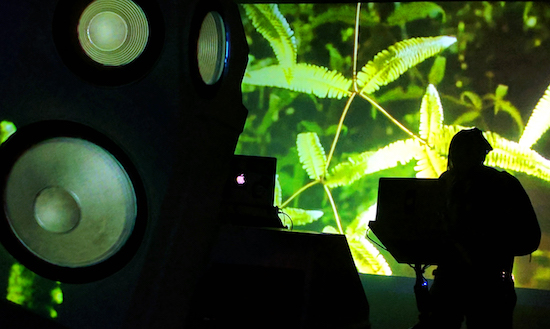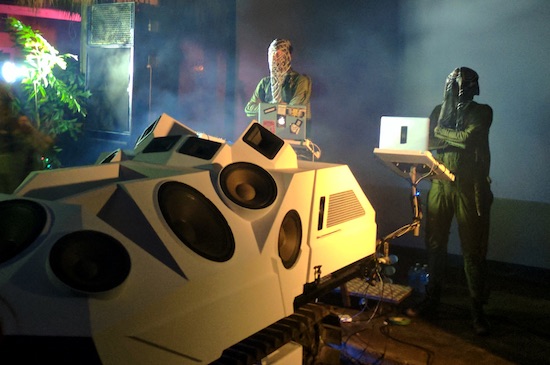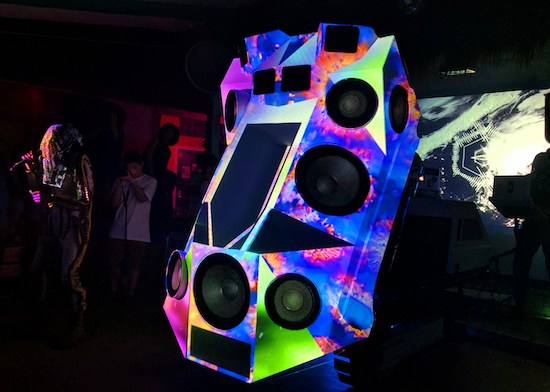15kHz-Frequency Check
At the opening press announcements for Art Basel 2016, the mayor of Miami Beach, Philip Levine, takes the stage and makes a sly comment thinly veiled as a joke: "We need more land, and we might have to take it from the Wynwood neighborhood. I’m not sure how we’re going to do that – but it might have to be done through military force." Vague chuckles in the audience – is he really joking? Is this a good time to be making light of displacing people by force from their communities? Spokespeople on stage claim art and its capitalistic benefactors saved Wynwood from itself by creating "new geographic districts," allowing communities to form where before there were apparently none. Klaxons of suspicion sound off in my head.
This statement about taking a neighborhood by "military force" creates a perfect circuit back to the German artist Nik Nowak’s 4000-watt mobile subwoofer sound system sculpture – the Soundpanzer – which was soon to exchange friendly soundclash fire with Miami Bass legends, Bass Mekanik (Neil Case and DJ Billy E), at an event in Wynwood. Perhaps the promise of gut-wrenching bass music and the dark ecological revenge of Zika-bearing mosquito swarms are what one should happily glom onto while railing against the grosser aspects of Basel. Bass and its lowest registers will act as a rally cry for community over the next few days. To quote the vocoder-voice question in the opening of Maggotron’s ‘Bass It, Y’all’ track: "Is there anybody out there?"
Major Hertz-Jack Mullin
Jack Mullin, an engineer in the United States Signal Corps, was deployed to England during WWII to help solve the problem of radio interference. Working late into night, he would listen to BBC radio until he was met with the dull silence of the sign-off at midnight. A sweep of the dial tuned Mullin’s ears towards Germany; they apparently found radio orchestras with the stamina to play 24/7. Mullin might have rightfully assumed it was all part of a propaganda ploy to keep Teutonic wartime spirits high.
When Mullin was dispatched to Germany in 1945 to investigate the country’s top-secret electronics, he discovered the truth about all-night broadcasting at a Radio Frankfurt outpost operating in a castle in Bad Nauheim. The Germans had been using magical recording machines called Magnetophones. Mullin asked for a demonstration: "I really flipped. I couldn’t tell whether it was live or playback. There simply was no background noise."
Mullin liberated two Magnetophones and sent them home to adapt for American use. According to wartime souvenir rules, Mullin broke the machines into 35 separate packages to fit into standard mailbags, reassembling them back in San Francisco. Mullin demonstrated the modified Magnetophone for the Ampex Corporation, who were impressed. The Frankensteined German recorders soon became too finicky to use, but their death rattles reached the ears of those who believed in their power. His twin deck Magnetophones laid the groundwork for the Ampex 200A.
A very specific circadian shift in sonic headspace occurred in the United States in the late-1940s as a direct outcome of the technical lineage that emerged from military hardware and onto wires and reels. New patterns in passive listening emerged with pre-recorded broadcasts, which soon bled into the night. Insomniacs tuned in to the hush of tableside radios; soon there would be no memory of how things were before "beautiful night music" went on late. It sounds like someone is out there.
8hZ – How to Make an Art out of a Ripped Eardrum

Nik Nowak is an artist, musician, and documenter of mobile sound systems. Based in Berlin, he was born in Mainz, Germany – a city 70km southwest from where Mullin pilfered his Magnetophones. The psychic imprint of Mainz includes intense bombing campaigns during WWII as "Willie Peter" (aka white phosphorous) bombs were dropped by the Allies to crush local morale in the later years of the war. Thousands of tons of munitions nearly matched the number of casualties. As a child in the 1980s, Nowak and his friends accidentally wandered into the territory of an American military barracks in Mainz, where they saw soldiers attempting to blend with nature with camouflage gear and leaves in their craw. No surprise then that Nowak’s work references the push-pull aesthetics and use of sound as both cultural transmitter and as acoustic weapon.
When Nowak and I meet for the first time, we bond for a moment over our love of the MPC2000 and our mutual rarified hearing impairments – how it affects our sonic range in producing and listening to music. I have the suboceanic drop-out phase of Meniere’s disease, he the carrier of the more violent aural inscription of a blank bullet shot next to his ear in a club when he was a teenager. He tells me: "I fell on the ground, lost all orientation; and I had this moment of being shell-shocked, and then I was okay. Later, I didn’t want to go to military so I tried to work out where my inabilities were. That was when I found out that my hearing in that right ear is cropped at 8 kHz – the typical frequency that happens when the eardrum rips and grows back together. That was where I started to get interested in the limitation of our sensorium. But bass is just beautifully mono; it’s calming, it’s comforting."
Nowak trained as a painter during his academic career and by 2005, he began to create soundscapes to accompany the process of creating gaffer tape wall drawings. The necessity of mobilizing sound into different locations resulted in the acidic green Sound Booster: "It was already clear that it was an absurd idea, but it was coming from this dilemma – and then I started to work with the idea of dilemmas. These sound sculptures are always absurd because they look very mobile but they are very difficult to move." Nowak recently became one of the first residents in the Sennheiser Future Audio Artists program, which has helped him to push the technical boundaries of his work forward through access to equipment and collaboration with the company’s engineers. The debut of his Soundpanzer on American soil at Miami Basel would lead to heavier dilemmas for Nowak. Exactly how does one free 1.5 tons worth of speaker power from the customs dock?
The fourth Order of Hertz: Magnetic Hysteresis Loop
After the press conference, I find a voicemail from Dave Tompkins, writer and organizer of the soundclash event, itself partly a freak offshoot of the research for his forthcoming book on Miami Bass and the natural environment: "Get over to Gramps – the bass tank is imminent."
When I ask Nowak how the idea for this event came about, he tells me it began as a joke: "Dave was researching his new book about bass culture and was writing about shellfish, and corals, and how they are influenced by acoustics and sound. He said ‘why don’t you build a bass submarine and bring it over?’ He was joking, but when Sennheiser asked me to come to Miami, the first thing I did was call Dave and say ‘okay, now is the time. Let’s do it.’" Nowak began to imagine a mutated version of a mobile audio clash between the Soundpanzer and a system from Miami – two different sound technologies infused with contrasting cultural and social references. To support the Soundpanzer’s corner, Nowak looped in his long-time collaborator – the Berlin-based artist Moritz Stumm – to create the lush video projection mapping that would soon fill the surface of the tank. Infinite Livez, a musician and artist from London who "has reoccurring dreams of the end of the world" filled the essential role of MC at the event. Bass Mekanik (Neil Case and Billy E) were brought on board to represent Miami sound with their Boom Style van.
When I arrive at the open-air tropical-themed club called Gramps, I find someone painting Pac-Man ghosts, wiener dogs, and petitions to "get money" with purple tempera paint on the sidewalk out front. Behind a large blue GMC van plastered with Orion Car Audio graphics, I’m introduced to Case and Billy E, who are busy rewiring batteries and subwoofers in the back of their vehicle. Billy tells me he bought the van in the early-1990s with the first royalty cheque from his classic release Nightmare On Bass Street. He flows off the van’s specs like water: 16K RMS, 32K nominal, 64K peak power filtered through nine 15-inch subwoofers, something about a fourth order bandpass box and 160db. I nod, out of my league; I assume it’s going to be… "loud." I get a first taste of Miami competitive audio power as Bass Mekanik tests their work. I witness a mosquito get hit by a shockwave and land to regroup on the bench beside me. I feel a persistent vibration through the earth and thinking about magnetic needles on wax threading their way through something-odd hertz, now translated into the spin of 23,000 rpm CD-Rs on the deck.

At about 2:30pm, a shipping container marked "Hamburg Hoch 11" arrives, carried on a flatbed truck bearing mud-flaps embossed with the text "Tropical Trailer Leasing." The tank leaves scratches in the streets. Nowak tells me: "I make drawings with the tank sometimes. I’ve made a whole series of drawings cut into paint with the tracks – they’re called ‘dub plates’." David Toop has a lot to say about dub in Ocean Of Sound, and considering the coastal geography of Miami, this quote works well: "Dubbing at its very best takes each bit and imbues it with new life, turning a rational order of musical sequences into an ocean of sensation … It is no coincidence that the nearest approximation to dub is the sonar transmit pulses, reverberations and echoes of underwater echo ranging and bioacoustics."
Nowak thinks a lot about the physicality of sound and the bleed-over between music and landscape: "Sound system culture has really a lot to do with physical machinery because to produce the sound and especially the bass frequencies, you need to move air – a lot of it. You need the machinery to do this, and through its physicality, it becomes something local. It isn’t just the people and the social and political situations, it is also connected to the supply of technology. Often the technology that is available for these sound system cultures comes from military backgrounds, and find their way back into civil societies and totally change the purpose and the nature of what their original intended use was."
Despite the appearance of the Nowak’s tank and it’s overt aesthetic and political connections to military and macho culture, he tells me that both he and Bass Mekanik consider the personalities of each of their respective vehicles to be female.
45Hz: Subsonic (gonna drop it / gonna kick it)

The soundclash begins and the crowd adjusts to the knee grinding shake. I’m standing by the first contender (the Bass Mekanik van) as everyone nearby grins at one another in appreciation of the very hyped up guy screaming "Stick your head IN THE VAN!!!" over and over. In retrospect, I wonder at what wattage his lungs were aspirating, because it seems impossible that anyone could have heard him over the ground-shaking boom. I grab the frame of the van’s open door and my wrist wobbles and I have to keep pushing my custom molded earplugs back into place as they rattle free from my ears. The infectious head nods of Billy and Neil sitting in the front seat transfer over to the crowd and everything seems to be bouncing. People hop in and out of the vehicle to have their synapses exploded for ten seconds at a time.
The Soundpanzer commands the crowd’s attention as it sounds off with an entry blast of booming bass woven into interlocking circles. Nowak and Stumm stand behind the tank with laptop rigs while Inifinite Livez toasts over the music and stomps around with a force of command fitting for a flag-waving MC. The trio are dressed in form-fitting camouflage future suits, faces obscured by silky bandanas with natural patterns. With leafy twigs and branches phasing in and out of focus they seem to be visual forces of nature. Playing at that childhood memory of stumbling upon soldiers hidden in the woods, Nowak now blasts back with a retroactive acoustic assault. The tank starts out flat to the ground, but half-way through the set, Nowak – determined to amp the crowd up to the next level – hops into the crawler and activates the hydraulics to raise the tank’s body to an upright position, creating an aestheticized speaker wall.
Moritz Stumm’s video projections behind the tank dig deep into the echo chamber of history and the push and pull of politics, building walls both physical and psychic, marching soldiers, riots and the subjugation of citizens. A wave of present-day catharsis with the grainy footage of someone holding an "Evict Trump" sign. It’s all chaos and crackle and noise; there are some death metal fans buried in the mix somewhere. The loose concept of magic by contagion seems to be at work as the images bleeding onto the tank become counterpoints to the implied violence behind it. It becomes a "pictorial instrument" deconstructed into pure signal. It is no longer a loose carbon copy of a military vehicle, but a beacon filled with gentle flowing corals, water, greenery, and abstract patterns.

The tank seems to be acting as a bleached-out reversal of the black box. It is a white box with mutable projections, playing somewhere between receptacle and depository. The Soundpanzer is the point of entry to Nowak’s mutable audio-visual essay into which the crowd allows itself to be swallowed. The collective bass-eating grin carries tension and release. It skews dark at times, but the balanced moments of absurdity prompt wondering, head-shaking laughter as people embrace the skewed sensorial ratios brought on by low frequencies, high humidity, and the mid-tones of visual static. To say that the soundclash was nothing more than a party is to negate the deep history of political sound that Nowak is always careful to credit:
"If you look at sonic weapons and what they do, it is mostly just to oppress groups or to produce fear. But if you think about sound system culture its always about creating a dome – even a dome of discourse – through music. Yesterday, at the soundclash at Gramps it worked like a dialogue. There were entertaining party moments, but it always came back to really serious aspects. I mean, music is positive and peaceful, but it is also a vehicle to deal with all of the shit in the world. For people that are not the ones to create that shit – but the people who have to deal with it."
10Hz: The Brain Coral that Ate Miami M

The day after the sound clash, when I ask Nowak who "won" the battle he laughs: "We all of us were the winners, because the whole situation looked impossible." I join the group of people now taken to calling themselves The Bass Crew for a visit to the Coral Morphologic lab, part aquacultural archive, part subaquatic media creator. After the excessive frequencies of the evening before, it seems a therapeutic counterpoint could be found in staring at coral in reverent silence.
In a room bleached blue with ultraviolet light, Colin Foord and Jared McKay tell us about the Banggai Cardinal Fish’s mating habits (the male incubates the eggs in his mouth and goes hungry until they hatch, an act called "mouth brooding"). Foord shares the theory of the evolutionary symbiotic attraction that humans seem have with corals. We are captivated by their fluorescing qualities, and are drawn to collect and protect them. But this level of mutual commitment is in turn a bizarre way of behaving because as Foord asks us: "How do you build empathy with brainless, faceless creatures?" I learn that coral forms its own frontiers and border walls around Miami, beneath the streets. The vibrating edges of non-human codes of time, human and coral profiting from one another’s presence (but never going so far as to rename one another’s neighbourhoods or threaten military takeovers).
Talk goes deep with tales of Cthulu’s supposed place of imprisonment and the reality of The Bloop’s sound being linked to the shearing off of an underwater ice-shelf. The clash of the Anthropocene era – the handshake of industry and human and the quiet smear of geological time. Reginald Fessenden’s hydrophones and amplifying the clicks and pops of coral voices. I flock to the neon orange subwoofer-esque zoanthids and am happy to be told that these are the same corals that were projection-mapped onto the surface of the Soundpanzer the night before. Corals engage in turf battles using sweeper tentacles that come out at night and wage growth inhibitor chemical warfare. One damaged coral in the tank was partially digested by its neighbor overnight. So maybe coral are really not all that different from the sound clash or acoustic warfare – or even human gentrifiers – after all. More epigrams follow as we sink deeper: "What is death to a clone?" And the best thing I’ve heard all year that isn’t music or those beautifully mono bass tones: "The tongue coral has many mouths."
Kristen Gallerneaux is an artist, curator and media historian. Her book, High Static, Dead Lines will be published by Strange Attractor press in Fall 2017.


